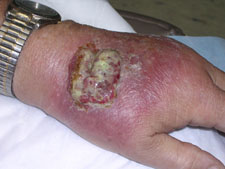Spurred to research further, based on the current setting in Jackson, WY.
Interesting to know. It doesn't sound apocalyptic though something worth evaluating while glassing when hunting.
@Hunting Wife , @brocksw , others in the know, thoughts?
1.) How frequent does orf virus occur w/in common big game animals? I.e. elk, deer, pronghorn.
2.) If identified when ready to harvest, using neoprene gloves via gutless method, it sounds like a person is still vulnerable if it touches any exposed skin?
3.) Is it safe to eat if found with the possible lesion(s)?
From my PhD in Googology, it appears predominately within sheep and goats, however also found from elk to pronghorn. AKA, Deer Parapoxvirus.

 buckrail.com
buckrail.com
USFWS Identified on the elk refuge outside Jackson, WY.
"Bighorn sheep on the National Elk Refuge are used to cars and people; when they approach a car to lick its salt and mineral deposits, they can spread the virus among the herd, and put humans at risk of contracting the virus."
Known as Orf Virus.
 www.cdc.gov
www.cdc.gov
"Lesions (one to a few) or nodules will often occur on the fingers, hands, or the forearms."
"Lesions generally range in size from 2-3 cm but can be as large as 5 cm. They can be painful but usually resolve on their own without scarring."

Interesting to know. It doesn't sound apocalyptic though something worth evaluating while glassing when hunting.
@Hunting Wife , @brocksw , others in the know, thoughts?
1.) How frequent does orf virus occur w/in common big game animals? I.e. elk, deer, pronghorn.
2.) If identified when ready to harvest, using neoprene gloves via gutless method, it sounds like a person is still vulnerable if it touches any exposed skin?
3.) Is it safe to eat if found with the possible lesion(s)?
From my PhD in Googology, it appears predominately within sheep and goats, however also found from elk to pronghorn. AKA, Deer Parapoxvirus.

Bighorn sheep on Elk Refuge showing signs of virus
JACKSON, Wyo. — Bighorn sheep spending the winter on the National Elk Refuge are displaying signs of orf virus infections, according to an announcement by the U.S. Fish and Wildlife Service. Also known as contagious ecthyma, the virus manifests in the sheep as “scabby sores around their lips...
 buckrail.com
buckrail.com
USFWS Identified on the elk refuge outside Jackson, WY.
"Bighorn sheep on the National Elk Refuge are used to cars and people; when they approach a car to lick its salt and mineral deposits, they can spread the virus among the herd, and put humans at risk of contracting the virus."
Known as Orf Virus.
Infection in People | Orf Virus (Sore Mouth Infection) | Poxvirus | CDC
Orf, sore mouth infection in people.
"Lesions (one to a few) or nodules will often occur on the fingers, hands, or the forearms."
"Lesions generally range in size from 2-3 cm but can be as large as 5 cm. They can be painful but usually resolve on their own without scarring."





